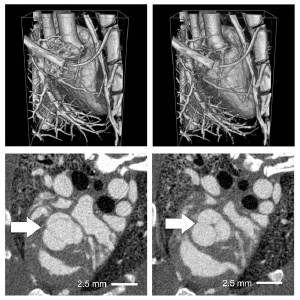Nov 6 2008
A RIKEN-led team has designed and constructed a high-resolution, computed tomography (CT) system that can visualize the motion and deformation of the heart, coronary arteries and small airways of live rats and mice, the animals most often used as models for human disease.
 Examples of high-resolution images of a beating rat’s heart produced using the new micro-CT system (top: whole heart; bottom, cross-section at aortic valve)
Examples of high-resolution images of a beating rat’s heart produced using the new micro-CT system (top: whole heart; bottom, cross-section at aortic valve)
These internal movements are integral to understanding respiratory and cardiovascular diseases, and therefore to the development of effective treatments. They are also influenced by drugs, and hence can be used in testing and development of new therapeutic compounds.
The condition of the heart is manifested in its rhythmical beating, and the location of fatty deposits, which can lead to heart disease, is influenced by motion of the arteries. Deformation of the airways affects gas exchange and deposition of particles, and initial results from the new system already show that changes in diameter are larger in smaller airways.
In the past five years, several systems have been proposed and developed for imaging the heart and lungs of small living animals, but none have been sharp enough to detect the motion of arteries and small airways. The highest potential resolution can be obtained using x-ray based, micro-CT, but the sample animal needs to be as still as possible. When imaging the heart, the movement of the lung needs to be minimized, and vice versa. So, data to construct the images needs to be collected under certain prescribed conditions.
In a recent paper in Physics in Medicine and Biology*, researchers from the RIKEN Advanced Science Institute in Wako and other Japanese institutions explain how they dealt with these problems.
They used synchrotron radiation at the SPring-8 Center in Harima, which is much more powerful and predictable than standard laboratory sources, and so achieves high contrast resolution and minimizes blur. The shutters for x-ray source and detection were synchronized. The sample rodents were anaesthetized, put onto a ventilator, and connected to an electrocardiogram (ECG) machine. The researchers were then able to acquire data at controlled airway pressures and time observations for the periods between heart contractions. For heart and arteries, image acquisition could be timed for the end of breath expiration.
The sharp images during dramatic motion thus obtained allow calculation of gas exchange in small airways, and of shear stress in blood vessels, an important factor in deposition of plaques. “This development is a significant step in our program to create a computer model of the human body,” says Ryutaro Himeno, who heads the research team.
- Sera, T., Yokota, H., Fujisaki, K., Fukasaku, K., Tachibana, H., Uesugi, K., Yagi, N. & Himeno, R. Development of high-resolution 4D in vivo-CT for visualization of cardiac and respiratory deformations of small animals. Physics in Medicine and Biology 53, 4285–4301 (2008).